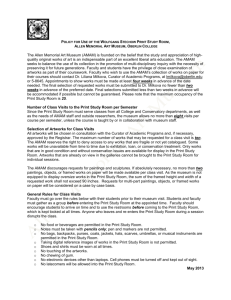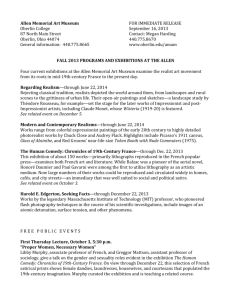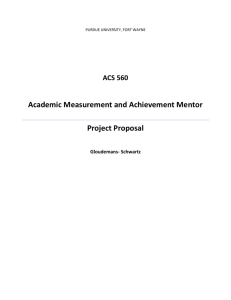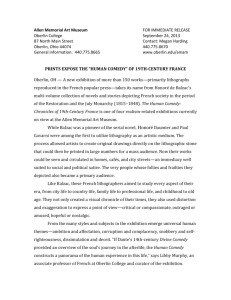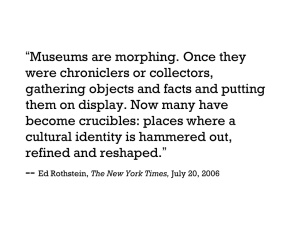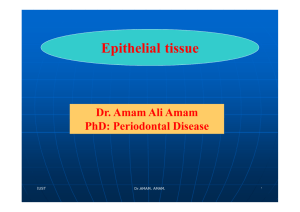Curriculum Development Grants
advertisement
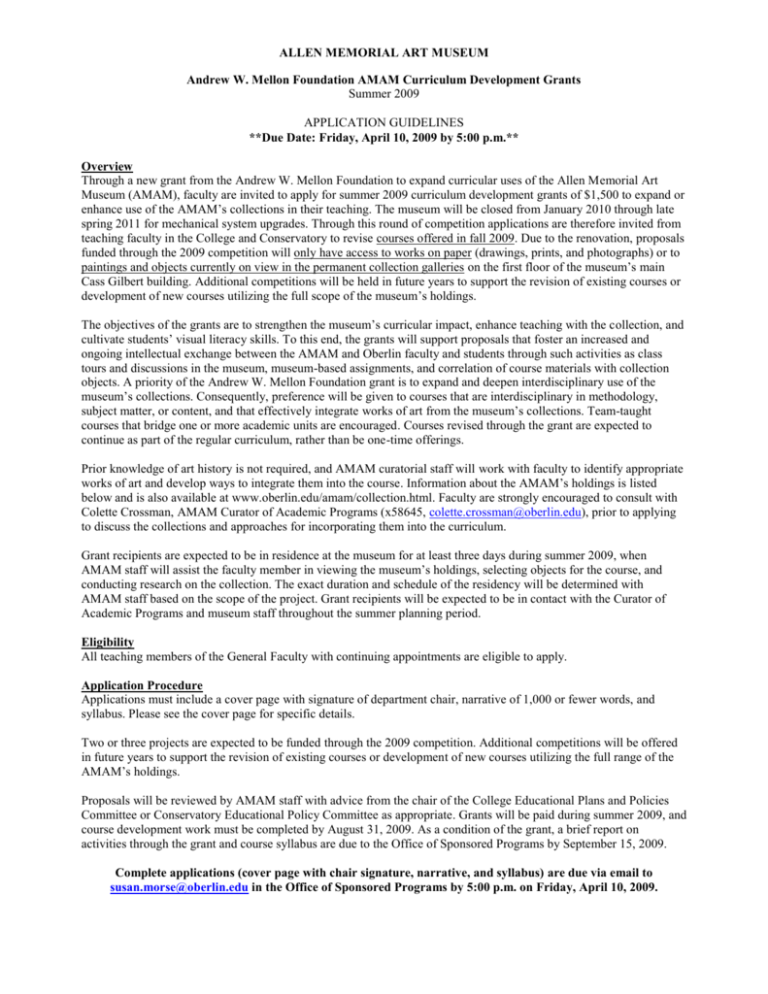
ALLEN MEMORIAL ART MUSEUM Andrew W. Mellon Foundation AMAM Curriculum Development Grants Summer 2009 APPLICATION GUIDELINES **Due Date: Friday, April 10, 2009 by 5:00 p.m.** Overview Through a new grant from the Andrew W. Mellon Foundation to expand curricular uses of the Allen Memorial Art Museum (AMAM), faculty are invited to apply for summer 2009 curriculum development grants of $1,500 to expand or enhance use of the AMAM’s collections in their teaching. The museum will be closed from January 2010 through late spring 2011 for mechanical system upgrades. Through this round of competition applications are therefore invited from teaching faculty in the College and Conservatory to revise courses offered in fall 2009. Due to the renovation, proposals funded through the 2009 competition will only have access to works on paper (drawings, prints, and photographs) or to paintings and objects currently on view in the permanent collection galleries on the first floor of the museum’s main Cass Gilbert building. Additional competitions will be held in future years to support the revision of existing courses or development of new courses utilizing the full scope of the museum’s holdings. The objectives of the grants are to strengthen the museum’s curricular impact, enhance teaching with the collection, and cultivate students’ visual literacy skills. To this end, the grants will support proposals that foster an increased and ongoing intellectual exchange between the AMAM and Oberlin faculty and students through such activities as class tours and discussions in the museum, museum-based assignments, and correlation of course materials with collection objects. A priority of the Andrew W. Mellon Foundation grant is to expand and deepen interdisciplinary use of the museum’s collections. Consequently, preference will be given to courses that are interdisciplinary in methodology, subject matter, or content, and that effectively integrate works of art from the museum’s collections. Team-taught courses that bridge one or more academic units are encouraged. Courses revised through the grant are expected to continue as part of the regular curriculum, rather than be one-time offerings. Prior knowledge of art history is not required, and AMAM curatorial staff will work with faculty to identify appropriate works of art and develop ways to integrate them into the course. Information about the AMAM’s holdings is listed below and is also available at www.oberlin.edu/amam/collection.html. Faculty are strongly encouraged to consult with Colette Crossman, AMAM Curator of Academic Programs (x58645, colette.crossman@oberlin.edu), prior to applying to discuss the collections and approaches for incorporating them into the curriculum. Grant recipients are expected to be in residence at the museum for at least three days during summer 2009, when AMAM staff will assist the faculty member in viewing the museum’s holdings, selecting objects for the course, and conducting research on the collection. The exact duration and schedule of the residency will be determined with AMAM staff based on the scope of the project. Grant recipients will be expected to be in contact with the Curator of Academic Programs and museum staff throughout the summer planning period. Eligibility All teaching members of the General Faculty with continuing appointments are eligible to apply. Application Procedure Applications must include a cover page with signature of department chair, narrative of 1,000 or fewer words, and syllabus. Please see the cover page for specific details. Two or three projects are expected to be funded through the 2009 competition. Additional competitions will be offered in future years to support the revision of existing courses or development of new courses utilizing the full range of the AMAM’s holdings. Proposals will be reviewed by AMAM staff with advice from the chair of the College Educational Plans and Policies Committee or Conservatory Educational Policy Committee as appropriate. Grants will be paid during summer 2009, and course development work must be completed by August 31, 2009. As a condition of the grant, a brief report on activities through the grant and course syllabus are due to the Office of Sponsored Programs by September 15, 2009. Complete applications (cover page with chair signature, narrative, and syllabus) are due via email to susan.morse@oberlin.edu in the Office of Sponsored Programs by 5:00 p.m. on Friday, April 10, 2009. ALLEN MEMORIAL ART MUSEUM Overview of Museum Collections Founded in 1917, the Allen Memorial Art Museum (AMAM) is one of the finest college or university collections in the United States. Comprising more than 13,000 works of art from virtually every culture and spanning the history of art, the AMAM's collection is a vital cultural resource for the students, faculty, and staff of Oberlin College as well as the surrounding community. Notable strengths include 17 th-century Dutch and Flemish art; 19th- and early 20th-century European and contemporary American art; and Asian, European, and American works on paper. African Art Dating from the fifteenth to the mid-twentieth century, and primarily from West and Central Africa, the Allen Memorial Art Museum’s African collection is diverse and includes several extraordinary works in a variety of media. The African collection will be unavailable for consultation until after the building renovation. Ancient Art The collection of ancient art in the Allen Memorial Art Museum includes choice works, including many coins, from the cultures of the ancient Mediterranean – predominantly Greece, Egypt and Rome – as well as objects from Hittite, Sumerian, Persian, Etruscan, Phoenician and Cypriot cultures. Additionally, the collection includes a number of objects from the Ancient Americas, predominantly Mexican and Peruvian in origin. Asian Art The AMAM’s Asian holdings include a number of fine Chinese, Japanese and Korean paintings and decorative arts, spanning the centuries from ancient to contemporary, as well as an outstanding group of carpets. One of the most renowned aspects of the Asian collection is the over 1,500 Japanese woodblock prints bequeathed by Mary A. Ainsworth, Oberlin College class of 1889, upon her death in 1950. Assembled in part during her many trips to Japan in the late 19th and early 20th centuries, the Ainsworth collection is one of the most extensive Japanese print collections at any US undergraduate institution. Today the AMAM collection of Japanese prints numbers nearly 2,000 and is known for its depth, quality, and variety of subjects. Modern Art Nineteenth- and early 20th-century European and American painting is represented at the AMAM with important works by artists such as J. M. W. Turner, Paul Cézanne, Pierre-Auguste Renoir, Edgar Degas, Ernst Ludwig Kirchner, Henri Matisse, Auguste Rodin, Amedeo Modigliani, Alberto Giacometti, and Alexander Calder. Particularly important to the AMAM’s teaching role are the unusually large numbers of works dating from early in the careers of artists who later created significant monuments in the history of art. For example, the collection contains key early works by Thomas Cole, Claude Monet, Piet Mondrian, and Pablo Picasso. Old Masters The Allen Memorial Art Museum’s collection of Italian Renaissance and Baroque art, which comprises important paintings, sculptures and drawings, is particularly strong. The collection benefited from the donation of ten paintings from the Samuel H. Kress Foundation, and was additionally formed by many judicious acquisitions. In addition, the AMAM houses an extensive collection of 16th- and 17th-century Netherlandish, Dutch and Flemish art, including outstanding landscapes, portraits, history paintings, scenes of daily life, and etchings by Rembrandt. Painting and Sculpture Since 1945 The importance of the modern and contemporary collection at the AMAM developed from the legacy of Oberlin’s legendary professor of art Ellen Johnson (1910–1992), who championed contemporary art at Oberlin through artists’ residencies, exhibitions, and acquisitions for the museum’s collection. The Allen began seriously collecting contemporary art in the late 1950s, under Johnson’s leadership. The Allen Memorial Art Museum’s extraordinarily broad collection of art made since 1945 represents all the major postwar practices, including abstract expressionism, minimalism, pop, and conceptual art, as well as contemporary art in a wide variety of media. Contemporary AfricanAmerican Art has also been a particular focus of acquisitions in recent years. Most post-1945 painting and sculpture is currently in storage and will not be available for consultation until after the building renovation. Weltzheimer/Johnson House The Weltzheimer/Johnson House at Oberlin College is a Frank Lloyd Wright Usonian House that sits on a 3 acre lot several blocks from campus. Designed in 1948 and completed in 1950, it is the first Usonian house in Ohio and one of the few in the nation open to the public. ALLEN MEMORIAL ART MUSEUM Works on Paper Exceptionally strong holdings of prints, drawings, and photographs supplement the paintings and sculpture on view in the AMAM galleries. Prints comprise the largest group of objects in the AMAM collections, numbering over 7,500, including the Ainsworth collection of Japanese woodblock prints. Drawings – including watercolors and mixed media on paper – number over 1,000. The AMAM collection also has over 700 photographs, including a recent gift of 150 Andy Warhol photographs donated in 2008 by the Andy Warhol Foundation for the Visual Arts. In addition, the Museum houses the Eva Hesse Archive – the artist’s notebooks, diaries, photographs, and letters – which consists of nearly 1,000 objects.
